|

a


Part 1 | Part 2

an and Brian brought along all but one of the Peter Lehmann wines
currently imported into the US from Australia. “That will grow, as time
goes on,” according to Brian. We started with some selections from the
Barossa range of wines, which sell for $25 and under. I was only able to
get some quick “snapshots,” if you will, but I liked everything that we
tasted. Ian added in - depth commentary on most of these.
 2003
Peter Lehmann Eden Valley Riesling, $14.99, 11.5% alc.: Pale to
medium straw, showing some petrol over steely green apple and lime, with
rich flavor, undertones of minerality and a full, round mouth feel. Very
nice indeed. 2003
Peter Lehmann Eden Valley Riesling, $14.99, 11.5% alc.: Pale to
medium straw, showing some petrol over steely green apple and lime, with
rich flavor, undertones of minerality and a full, round mouth feel. Very
nice indeed.
Ian: Eden
Valley is one of the great Riesling districts of Australia. The two main
regions, in my opinion, would be the Clare Valley and the Eden Valley,
producing two different styles. Clare is slightly more floral, whereas
Eden Valley has a steelier acid, (is) very linear and just oozes what we
call pure lime juice. I still see quite a lot of lime in this wine. We
have quite a few guys in that district with Riesling in, and one of our
great strengths is that all our eggs are in one basket.
We also make a Reserve Riesling, which is five year release, it’s
produced from the finest parcels of the vintage, and we don’t pretend to
guess which vineyard that’s going to come off. We just put them all
through our winemaking process and the great wine shines at the end of
the vintage.
2002 Peter Lehmann Barossa Semillon, 12% alc.: Medium straw, with
green apple, lime and pear flavors and aromas, and just a hint of the
bees wax and lanolin that will surely develop with age. Clean and crisp.
Ian: We’re probably the largest buyer of
Semillon in our district, it’s a really important grape variety for us.
We use no oak, no malo, but we stir on (the) lees each week, and it
gives the palate a lot of creamy texture. As a young wine, it’s round,
it’s slightly soft and more approachable, it oozes a lot of citrus and
grapefruit character, but then when it starts to develop, it’ll get bees
wax (and) lanolin touches, and then becomes an incredibly interesting
wine.
It’s funny, because obviously Chardonnay is king over here (in the U.S.)
as a white wine, and in the Barossa, everyone drinks Riesling and
Semillon. It’s just what we grew up with. We sell a LOT more of it than
Chardonnay, and it’s a wine we love to make and love to drink. It’s
pure, clean fruit with amazing flavor, and they live forever. We drink
’80, ’81, ’82 still, it’ll age more gracefully than
Chardonnay; it ages more than Riesling does.
2003 Peter Lehmann Eden Valley Barossa Chardonnay, $19.99, 13.5% alc.:
Pungent, steely, rich, round fruit, with true Chardonnay character; nice
balance and cut, with the acidity that it needs to go well with food or
just to sip on a nice hot summer day. A subtle kiss of oak takes nothing
away from the fruit. Doesn’t smell or taste like no stinkin’ cookie
cutter Napa Chardonnay!
Ian: There’s so much focus on Riesling and Semillon, we probably don’t
play around with it (Chardonnay) as much as we could. We only use about
15% new French oak on it, and it’s only for about eight months, but
we’re playing around with wild ferment and lees stirring. We don’t use
malo in it because we feel that it kills fruit, it detracts from the
grape’s character. The Eden Valley (fruit) gives tartness, steeliness
and some structure to the wine and the Barossa just gives that beautiful
cashew, peach fruit (and) that lovely round flavor. There’s no extract
in white, and there’s a lovely, clean finish. We’re not interested in
making a big, fat, malo – y heavily oaked style, it’s not our way…,
we’ll remain with tight, fruit driven whites.
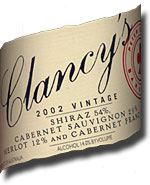 2002
Peter Lehmann Clancy’s Red Barossa, 54% Shiraz, 29% Cabernet Sauvignon,
12% Merlot, 5% Cabernet Franc, $19.99, 14% alc.: Ruby dark garnet,
with a judicious kiss of oak over red fruits; rich and round, with nice
structure and balance. Saw 12 months in new and old French and American
oak hogsheads. 2002
Peter Lehmann Clancy’s Red Barossa, 54% Shiraz, 29% Cabernet Sauvignon,
12% Merlot, 5% Cabernet Franc, $19.99, 14% alc.: Ruby dark garnet,
with a judicious kiss of oak over red fruits; rich and round, with nice
structure and balance. Saw 12 months in new and old French and American
oak hogsheads.
Hogsheads – 300
liter barrels, as opposed to 225 liter barriques: "There’s a big push
away from barriques in the Australian wine industry; it’s not value for
money and it’s too much oak. We’ve used barriques for a long time, and
you just get that extra kick of oak. We still have some barriques, but
we don’t focus on them as our major oak purchase."
Ian: Interesting vintage for us, coolest
vintage on record; we saw character in Cabernet and Merlot that we’ve
never ever seen before for purity of varietal character. It was a
wonderful vintage to make wine in. It was like everyone had a turn on
the merry – go – round; the varietal came around and then hopped off,
and then the next one hopped on.
So in ’02, we just saw fantastic Merlot, higher acidity in the reds than
we normally see, which has probably kept them a little tight. This is
the vintage that I think will rival ’98, but in a different way. ’98 was
amazingly muscular, it produced very big, solid, bold reds, whereas 2002
has produced amazing reds, but they’re more elegant, perhaps a little
bit more structured, and time will tell. In ten years time, we’ll do a
nice little vertical and see how they’re faring, but this will be quite
a bit different.
Clancy’s for us is a lighter, leafier style,
(with) a little bit more pepper. (There) are what we call our Barossa
blends, straight Shiraz, and straight Cabernet, where you’re looking
for, obviously, varietal definition, but these are sort of leafier,
lighter, softer components to make this wine, and I think that’s what
makes it very appealing, it’s just a great drinking red.
2001 Peter Lehmann Barossa Cabernet Sauvignon, $24.99, 13.5% alc.:
Dark garnet, with toast, smoke and a little matchstick over red and
black fruit; rich and pure in the mouth, this is a soft, pretty cab. Saw
12 months in wood, mostly French oak hogsheads.
Ian: Cab in the Barossa sort of plays
second fiddle to Shiraz, but this is all valley floor, nothing out of
the hills; we get a chocolatey style Cabernet, generally; in the great
years, we get more violet and cassis, and a lot more definition. ’01 was
a hotter year, so it was sort of hard to have a great Cabernet, but I
think this has turned out to be a pretty nice wine. Good structure, soft
tannins, it says “I’m Cabernet;” probably lacking a little bit of the
leaf and definition that we’re looking for, but you know, you gotta love
all your children. It’s a soft, pretty Cabernet. I think there’s a few
barrel characteristics on the nose; we tend to use heavier toasted
character in barrels to take the coconut character out, to get that
sweet lift, that savory oak character in our wine so that they don’t
over – dominate the primary fruit. We want it to just sit behind the
wine and help build on the wine without saying, “Is there any wine in
this oak barrel?”
"With Shiraz, it’s
just evil viticulture, no water, no fertilizer, no cover crops, just
plant a stick in the ground and hope it breaks through rock."
The following is the one selection from this lineup that I’d had
previously tasted (as well as twice since), so here are more in – depth
notes from those occasions. The wine has performed consistently on all
four occasions that I’ve tasted it, and is my go - to recommendation for
Oz Shiraz in the $15 - 20 range.
 2002
Peter Lehmann Barossa Shiraz, $19.99, 14% alc.: Deep dark garnet in
color, with a tight nose of blackberry, black cherry and dark plum that
echoes and expands on the palate with added hints of tar and chocolate.
This is no over-oaked, Aussie ooze monster; the deep dark fruit only
hints at a candied, overripe character, and the tannins really need at
least a few years to tone down for optimum drinking. Still, it’s a
decent match for a pan seared pork steak and scalloped spuds, and good
drinking by its lonesome too. Kim really likes this, and so do I; an
excellent wine from a great vintage, that saw 12 months in French and
American oak hogsheads. 2002
Peter Lehmann Barossa Shiraz, $19.99, 14% alc.: Deep dark garnet in
color, with a tight nose of blackberry, black cherry and dark plum that
echoes and expands on the palate with added hints of tar and chocolate.
This is no over-oaked, Aussie ooze monster; the deep dark fruit only
hints at a candied, overripe character, and the tannins really need at
least a few years to tone down for optimum drinking. Still, it’s a
decent match for a pan seared pork steak and scalloped spuds, and good
drinking by its lonesome too. Kim really likes this, and so do I; an
excellent wine from a great vintage, that saw 12 months in French and
American oak hogsheads.
From here, we moved on to two selections from Peter Lehmann’s Ambasador
range, the best wines that PLW makes.
1999 Peter Lehmann Mentor Barossa, 57% Cabernet Sauvignon, 20%
Merlot, 14% Shiraz, 9% Malbec, 13.5% alc.: Like the Barossa
Cabernet, another toasty, smoky nose, leading to silky soft red and
black fruit flavors and very nice depth of fruit; like velvet on the
palate, this is a beautiful wine. 16 months in French oak hogsheads
prior to bottling and cellaring for another two years.
Ian: The ’99 vintage was particularly
special to me, because it was my first vintage at Lehmann’s, and the
year my first son was born, so it was a good year for me. The Mentor is
a wine with tribute to Peter Lehmann as our Mentor. This wine,
predominantly Cabernet based, (comes) off dry grown vineyards in the
Barossa; these vineyards show an extra dimension of concentration,
color, varietal definition and tannin level and that’s what sets it
apart from Peter Lehmann Cabernet. I love the really velvety tannins
that our reds get, especially when they get some age on them; they’re
not dry tannins. We have the ability with this to use components of
other varietals, in many cases, that just don’t quite fit somewhere
else; too good to lose, too unique to stand on their own, but they’ll
always fit in Mentor. It’s a winemakers’ blend, it’s never the same.
So it’s only French oak, we use French oak in all our top reds, because
we feel it’s more subtle, it marries better, it’s got less aggressive
dry tannins and it will promote longevity. With some of the earlier reds
that we’ve seen, they were made with 100% American oak, and they’re
still great wines, but they’ve got a little bit of dryness, and we think
that French oak will be more harmonious.
"We say
'viticulture by neglect;' you go into these vineyards, and the wires are
rusty and broken, and there’s weeds and pigeons flying around, and
they’re hot and they’re dry, and the vines, they’re like Jesus dying on
the cross."
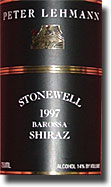 1997
Peter Lehmann Stonewell Barossa Shiraz, 14% alc.: We were getting on
with our tasting, and my notes were losing out to lively conversation
about the wines and PLW, but it can be said that this dark garnet beauty
shows a nice kiss of oak over old vine shiraz character, being soft,
balanced, lovely and expressive. A marvelous glass of wine, from the
very best Peter Lehmann Barossa Shiraz vineyards; 18 months in new
French (64%) and new American (36%) hogsheads, then bottled and cellared
for another 3 ½ years. 1997
Peter Lehmann Stonewell Barossa Shiraz, 14% alc.: We were getting on
with our tasting, and my notes were losing out to lively conversation
about the wines and PLW, but it can be said that this dark garnet beauty
shows a nice kiss of oak over old vine shiraz character, being soft,
balanced, lovely and expressive. A marvelous glass of wine, from the
very best Peter Lehmann Barossa Shiraz vineyards; 18 months in new
French (64%) and new American (36%) hogsheads, then bottled and cellared
for another 3 ½ years.
Ian: Stonewell Shiraz comes from the
deepest, darkest corners of the Barossa. It’s coming off our oldest
vines, planted in 1885, and owned by the same family since they were
planted. I’m always fascinated by how many horses and carts were dragged
up those 12 foot rows; 12 foot rows so they can drag a horse and plow,
it’s real old time stuff. How many people have pruned, and how many
people have walked past the vines each year? That thought just blows my
mind. It’s a piece of history, it’s old viticulture that doesn’t happen
any more. We say "viticulture by neglect;" you go into these vineyards,
and the wires are rusty and broken, and there’s weeds and pigeons flying
around, and they’re hot and they’re dry, and the vines, they’re like
Jesus dying on the cross.
Stonewell blocks are the first blocks that we pick, so we’re taking this
off before Semillon, before Riesling, before Chardonnay, and sometimes
it’s two weeks before we start anything else. The berries are hard and
dried out, and when you taste them, they’re immensely concentrated,
there’s no juice. The really noticeable thing about these grapes is the
thickness of the skins. You bite through it, you can feel yourself
piercing the skin; there’s a little seed, there’s pulp, and it’s dusty
and black.
Cabernet often needs a little bit of water in the
growing season, and if you get that, you can get good Cabernet. Cabernet
needs to hold leaf, and hold some shading in the Barossa; where Shiraz
can remain fully exposed, (with) Cabernet fully exposed, color
pigmentation breaks down and we lose varietal character. With Shiraz,
it’s just evil viticulture, no water, no fertilizer, no cover crops,
just plant a stick in the ground and hope it breaks through rock.
So we’ve got 20 blocks and about twelve growers that are up for
Stonewell classification. We never know which ones will get in; whenever
possible, we make them individual wines. If it’s too small a parcel, we
might combine two blocks that are being harvested at the same time
together in one tank, and basically just make a workable batch. In
ferment, they get black instantly, you can just see it, and you can look
in your glass and it’s got this black heart, (with) amazing potency
coming off the nose, it’s just like a concentration of pure cordial. And
even through that sugar, you get the beautiful dryness of the tannins;
even at the start, you can taste massive tannins in there.
We ferment it out, it takes about a week, then
we’ll leave it on skins for one or two more weeks, depending on the
structure of the wine in relation to the vintage, (and) press it off.
All our reds (are) free run, and pressings are combined, we never keep
them separate, it saves the harmonious balance of the grape, so we put
them all back together. We do barrel ferment, so we run off 300 liters
to the ton and ferment ‘em in some barrels, give ‘em a week or so; we’ll
then return that back to the tank and press it all off in one hit.
The wines’ll go through malo naturally, we don’t need to inoculate for
that; many of our reds come out of primary ferment, actually, through
malo, especially as the season goes on and there’s more natural flora
floating around the winery. Reds go through malo, they’re sulfured, put
into wood, classified, the blends are prepared, the blends are then
returned to wood, left for 12 months, pulled out at 12 months, (and)
tasted. If they need to go back in for a bit longer, it could be up to
another six months, they’re resulfured and go back in; otherwise, if we
think they’ve had enough oak, then we’ll just take them out and sulfur
them, coarse filter and prepare for bottling.
So, Stonewell; the first vintage was ’87, it was called “Cellar
Collection,” and in ’89 we called it Stonewell Shiraz. We own the vineyard,
one of the few vineyards we own, it’s in Stonewell, which is a little
non – officially defined sub – district of the Barossa.
(There is a) diversity that the region has in
micro – climates for these sub – districts. That’s just our strength, if
we get wiped out in one area by frost or rain or heavy winds or poor
set, at the other end of the valley or just around the corner, it can be
untouched, and having 190 families growing us fruit gives us an amazing
tapestry of options and opportunity, and we just thread ‘em together at
the end to produce our wines. That’s what gives us such strength and
consistency in our winemaking.
"I love single vineyard wines, but you know what? If
the vineyard had a shit year, you’re going to have a shit wine."
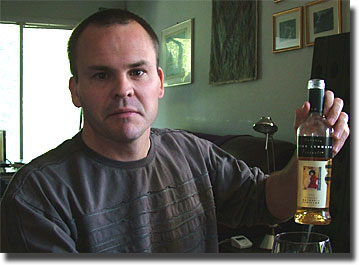 We
finished up with a nice sticky, which gave me some idea of the range of
really fine wines that PLW produces; remember, they also make fortified
and sparkling wines, which, as far as I know, aren’t yet imported to the
US. Ian and Brian were running short on time, so we didn’t have much to
spend on this, but it was lovely. Ironically, Kim arrived home shortly
after they left, so she got half of my glass of this, and liked it every
bit as much as I did. We
finished up with a nice sticky, which gave me some idea of the range of
really fine wines that PLW produces; remember, they also make fortified
and sparkling wines, which, as far as I know, aren’t yet imported to the
US. Ian and Brian were running short on time, so we didn’t have much to
spend on this, but it was lovely. Ironically, Kim arrived home shortly
after they left, so she got half of my glass of this, and liked it every
bit as much as I did.
2001 Peter Lehmann Barossa Noble/Botrytis Semillon, 11.8% alc.:
Rich golden color, with gorgeous, effusive sweet, ripe apricot and
marmalade flavors and aromas; unctuous, yet balanced, clean and
delicious.
Ian: We’ve made stickies since our
inception; it’s something that the Barossa’s always done. We used to
call Semillon Sauternes, but with the
French naming laws we now call it Botrytis Semillon. We put a vineyard, another one we added, it’s just
five acres, located at the bottom of the winery, resting in a gully,
surrounded by trees and trapped up against a river bank, so we get
beautiful conditions to get botrytis infection. We’ve gone and actually
put a sprinkler on every single vine, and we don’t need to spray for
botrytis, but we spray for humidity to get it going. Once we get it
going, then it just runs. But normally (in) Autumn, the fogs roll in,
they sit on this vineyard, they catch it in this little zone, wither the
grapes, wither the leaves, (with) perhaps a little dew over night, then
by lunch time, all blows over and it’s a hot beautiful day. And that
just dries it out again, so you get a very gentle, gradual ontake of the
mold. It’s a gray, blackie mold; it’s about six weeks to two months for
it to fully do its thing. We hand pick, crush, (and) soak for two days
on skins, then press it off as hard as we can. We soak it to rehydrate
the raisined berries and get their sugar out, and then we press it off
further, ‘cause it looks like duck shit, and then add yeast, get it
fermenting, split a bit off into some oak, get a bit going in there and
put it back together. (We get) great cleanness on the finish, we don’t
want that cloying treacle – like sensation. We want it to have fresh
fruit; apricot, pear, and effective sweetness without blowsiness. Tight
varietal white.
I really enjoyed tasting through these wines (I’ve since brought more of
the Riesling and Shiraz home, and I'm looking for some Semillon), and
got on quite well with Ian and Brian; these guys are fun to talk to and
taste with. The Clancy’s and Barossa Range bottlings show very good QPR
(quality – price ratio), and the Mentor and and Stonewell Shiraz are
certainly worthy of their higher price tags.
As they were leaving to drive to yet another trade tasting, I mentioned
to Ian that if I ever found myself Down Under, I’d like to pay a visit
to PLW, to which he replied, “Well, if you come
to Barossa and you DON’T visit, I’ll just have to hunt you down!”
I guess I know where I’ll be visiting the next time I’m in the Barossa!
Reporting from Day-twah,
Bastardo
|
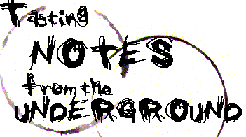

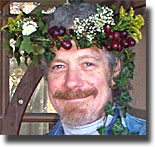





 We
finished up with a nice sticky, which gave me some idea of the range of
really fine wines that PLW produces; remember, they also make fortified
and sparkling wines, which, as far as I know, aren’t yet imported to the
US. Ian and Brian were running short on time, so we didn’t have much to
spend on this, but it was lovely. Ironically, Kim arrived home shortly
after they left, so she got half of my glass of this, and liked it every
bit as much as I did.
We
finished up with a nice sticky, which gave me some idea of the range of
really fine wines that PLW produces; remember, they also make fortified
and sparkling wines, which, as far as I know, aren’t yet imported to the
US. Ian and Brian were running short on time, so we didn’t have much to
spend on this, but it was lovely. Ironically, Kim arrived home shortly
after they left, so she got half of my glass of this, and liked it every
bit as much as I did.